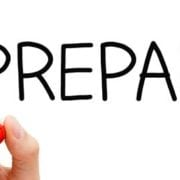
7 Steps to a More User-Friendly Disaster
The definition of disaster according to Merriam-Webster is a “sudden calamitous event bringing great damage, loss, or destruction.” Given that a disaster is, by nature, a bad thing, how can it be user-friendly? As with many things in life, it’s all in the preparation. Read the following 7 steps to make your next disaster more user-friendly, or skip to the bottom to listen to the Savannah Morning News podcast with some helpful tips on disaster preparation.
What is a User-Friendly Disaster?
You can be prepared for your kid’s college, you can be prepared for problems with the stock market, you can be prepared for your vehicle breaking down on the road…or you can be unprepared. How each of these things affects you has a lot more to do with how you anticipated the event and how you prepared for it than it does with the event itself.
Disaster preparation is no different.
Let me be clear: You are never going to be completely prepared for a disaster. It’s highly unlikely that you’re ever going to look back and say, “Wow, that was fun.” But the difference in preparation and lack of preparation determines whether it’s an event that you learn from and move on, or an event that shuts down your business and forces you to sell your home. These 7 steps are about how you can mitigate the effects of a disaster on your business, but the basic principles apply to most types of disasters that could occur in your life.
So let’s walk through a few steps that may help lessen the blow.
7 Steps for Disaster Preparation
- Have a plan. Ok, this sounds a bit like I cheated – pretty much a ‘duh’ moment – but it’s shocking how many businesses don’t have a plan. Either they feel they are just too busy, or they are complacent and assume ‘it will never happen to me.’ This is a huge mistake.
Even if you start small, just starting to jot things down on a tablet, start somewhere…today.
Also remember that your plan is a living document – you should be reviewing it a minimum of annually. Your business changes, your clients change, and technology changes; your disaster plan must change with them. - Consider the possibilities. What are your risks? What impact will different disasters have on you?
If you are a business based on knowledge workers (Insurance, for example) and you have your files in the cloud, technology could be set up so that none of the physical concerns below (Natural, Human intentional, most Miscellaneous) would have a significant impact on your business. On the other hand, if you are a manufacturer and the machines can’t run, much of your business doesn’t work.
Some of the major categories of disasters to consider:- Natural (hurricane, tornado, flood, fire [fire can fall under a few categories], earthquake)
- Human intentional physical damage (arson, theft, vandalism)
- Human internal (larceny, embezzlement, simple theft)
- Digital (crypto virus, other malware, hacking)
- Miscellaneous (plumbing, tree falls on roof, car crashes through window)
- Consider the cost. If you can send your team home or to a safer location, what’s the impact on your business? If they can’t communicate with each other, does that impact you? What about if you lose access to major systems or files? Can you calculate the actual cost in billings, in clients, in reputation?
- After you assess your exposure and the costs, consider how you might eliminate some of the exposure. For example, if you look at that closet full of paper files and realize that if it burned up, you’d be out of business, it might be time to take a serious look at integrating those files into your business systems or into a stand-alone document management system.
Consider your communication tools. If your company is like most, email is critical to your operation. Review how and where your email is hosted and how it’s backed up. If it’s not in a secure cloud environment, making that change may be a great step for your company. If your voice relies on a traditional premise-based phone system, you might gain significant advantages by moving to a cloud-based voice over IP phone system. Not only will this be flexible and redundant, it might actually save you money from the start.
As you review your line of business application(s), it’s quite possible that your vendor offers a hosted version that would work well for you. There’s also a case to be made for moving your entire infrastructure into a cloud environment. This technology will work regardless of what happens to your physical office, electrical power, and Internet connectivity. - Include the team. Doing this kind of planning in a vacuum is usually a mistake. While you may know your business well, if you have more than two or three people working for you, some of those people might have knowledge and insight that you may not. Share the plan with them, discuss openly, be receptive to feedback, and refine the plan.
- Work with your trusted partners. Your network Managed Services Provider should be right in the middle of this with you, helping you make strategic decisions for keeping the company safe. Discuss your plans with your CPA and attorney. All of these partners will have insights that you won’t have.
- Back it up. Last but definitely not least, understand what data you need, how often you need to back it up, where/how you are backing it up, and what happens in a disaster. A backup tape in a bank vault won’t help you if you don’t have a tape drive that will read it or if the bank is closed due to flooding. A great cloud backup won’t help you if the backup only keeps your data for seven days and your server was hacked into ten days ago.
There is no perfect disaster plan, and it’s never complete. There will always be one more thing that you didn’t cover. But if you think it through, revise as needed, and keep your trusted partners involved in the process, you can turn a disaster from being the end of an era for your business to just another experience that you worked your way through.
For more help with disaster preparation, click on the tags below for related information, or contact our team with your questions.











